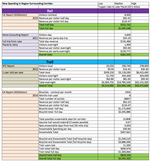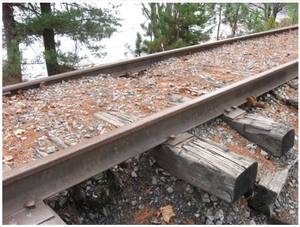Economics
Will it make money?
Short answer: yes. Any improvement on the Corridor would generate more income for the surrounding region. A full train service from Utica to Lake Placid would not only produce more income for ASR, but would also increase tourist related spending at train stops. The state would also receive some sort of payment for use of the Corridor. In the case of the trail, increased traffic around trail access points would increase business for food vendors and for businesses selling equipment for trail related activities (mainly bicycles, both repair and rentals). Finally, increased snowmobile use from removal of the tracks would increase fuel, food, and repair business all along the Corridor. Note that a parallel trail designed for bicycles and joggers would most likely not be able to support of the weight of snowmobiles, so the snowmobilers would still have to wait for the rails to be covered.
Any improvement of the Corridor will also create a short term boost in jobs during construction and a long term addition of a handful of maintenance jobs for the Corridor. The Camoin Study estimates that an upgraded rail line would create 13 new jobs while a trail would create 20 new jobs.
Image on the left shows one of the many potential uses for the Corridor, in this case transporting kayakers. Image from Stone Consulting Report cited below. Image on right shows that considerable repair work is needed in some areas and will definitely provide a short term boost to the local economies. Image from CA Report cited below.
Below is a chart showing estimated annual new spending from the different options from three different studies for a Tupper Lake to Lake Placid rail or trail: a report comissioned by the Rails to Trails Conservancy (RTC), a report comissioned by ADKAction.org from Camoin Associates (CA) and Barton & Loguidice, and a report on the Economic Impact of the Adirondack Scenic Railroad by Stone Consulting . The copies of these reports were obtained from the ARTA site. The data from the studies was put into a relatively uniform format to make the numbers more comparable, so some of the totals may differ from those listed in the reports. The green bars show the total new spending produced by each alternative according to the plans. Some things to note about the reports are:
- The Stone Consulting Report estimates are for a full rail line from Utica to Lake Placid
-
The RTC Report does not take snowmobiling or loss of train riders into account

- The CA Report only considers bicycle trail use to be new revenue as they argue other users will just shift spending patterns instead of creating new spending
- The CA Report only considers nonlocal use (80% of train riders and 53% of trail users)
- The CA Report assumes the Corridor is unusable by snowmobiles for 8 weeks out of the 12 week season due to the quantity of snow required to cover the rails
- The CA report adjusted the snowmobile spending per day so that only the revenue produced by 45 miles on/around the Corridor was considered
- The CA report listed spending values for a half-day trip and a full-day trip, and so both are listed to give an idea of the possible range of new spending
Finally, in the case that the Corridor was restored to a fully functioning rail line, the Adirondack Scenic Railroad believes that they would be able to run a profitable rail service along its length. A breakdown of their expected costs and revenues is listed on page 18 of their business plan.
Who is going to pay for it?
While there is huge debate over what the Corridor will be used for, there is little talk of who is going to pay for it. Based off of the costs page, the investment into the line is going to be huge. For such a large and costly item you would assume that the funding would be well known; however, it is only a small piece of the reports listed above:
- The RTC Report lists several possible federal funding sources both from transit programs (as cycling is a form of transit) and from natural resource improvement programs for funding a trail.
- The CA Report lists the federal DOT as a possible source for either rails or trail as well as several New York sources. These include two NY DOT programs, one supporting rails, the other trails. The New York State Office of Parks, Recreation, and Historic Preservation is listed as a possible source of trail funding as well as an Immigrant Investor Program.
- The Stone Consulting Report does not list any sources of funding. The UMP for the Corridor indicates that several small grants were obtained to start the scenic railroad, so funding sources such as these may exist (92-95).
- The Next Stop! Tupper Lake website indicates that they already have 2.4 million in funding for a Lake Placid to Saranac Lake trail parallel to the current rail line.
Other uses?
Only one major alternate use stands out: freight. However, according to the presentation at the public meetings concerning the Corridor this past Fall, for the Corridor to handle freight rail service it would need to be kept open year round, making it impossible for snowmobiles to use the Corridor (slide 18). Whatever economic gains were achieved by moving the freight would easily be negated by the loss of snowmobile tourism.
Also, looking back the the maps in “Status of Rail Around the Park” the Corridor seems very curvy compared to other rail lines around the state. This limits is use for purposes other than a tourist train, which moves slowly to afford a better view. Looking at a map of highways in New York State, the Corridor almost seems curvier than I-87: it definitely has more 90 degree bends. While that may have been acceptable when the line was built, you need much straighter lines to move people or freight in a reasonable amount of time in the modern world.


